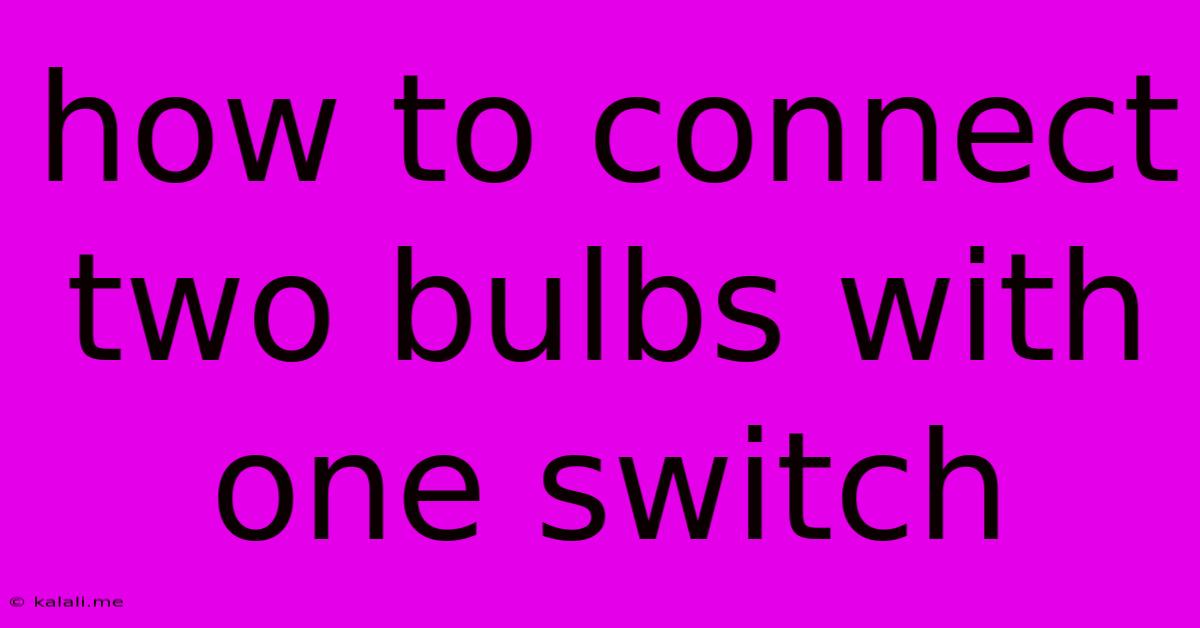How To Connect Two Bulbs With One Switch
Kalali
Jun 09, 2025 · 4 min read

Table of Contents
How to Connect Two Bulbs with One Switch: A Comprehensive Guide
Connecting two light bulbs to a single switch might seem daunting, but it's a relatively straightforward electrical task. This guide provides a step-by-step process, emphasizing safety precautions and clear instructions for both parallel and series wiring. Understanding the differences between these methods is crucial for achieving the desired outcome – two bulbs controlled by a single switch. Remember, always prioritize safety when working with electricity. If you're uncomfortable performing electrical work, it's best to consult a qualified electrician.
Understanding Parallel vs. Series Wiring
Before diving into the process, it's important to understand the two primary methods of wiring multiple bulbs to a single switch:
-
Parallel Wiring: This is the most common and recommended method. In a parallel circuit, each bulb receives the full voltage from the power source. If one bulb burns out, the other continues to function. This is safer and more efficient.
-
Series Wiring: In a series circuit, the bulbs are connected end-to-end. The current flows through one bulb, then the other. If one bulb burns out, the entire circuit is broken, and neither bulb will work. This method is generally less efficient and less safe for household lighting.
Tools and Materials You'll Need
Before starting, gather the necessary materials:
- Two light bulbs: Ensure they are compatible with your wiring and voltage.
- Two bulb holders (sockets): These should match the type of bulbs you're using.
- Electrical wire: Use appropriate gauge wire for the amperage of your bulbs.
- Switch: A single-pole switch is sufficient.
- Junction box: A suitable enclosure for the wire connections.
- Wire strippers/cutters: For preparing the wire ends.
- Screwdrivers: Phillips and flathead, depending on your switch and bulb holders.
- Electrical tape: For insulating wire connections.
- Voltage tester: Essential for verifying power is off before working on the circuit.
Step-by-Step Instructions (Parallel Wiring)
This method is the safest and most efficient for connecting two bulbs to one switch.
1. Turn Off the Power: This is the most crucial step. Locate your breaker box and switch off the breaker controlling the circuit you'll be working on. Use a voltage tester to confirm the power is off before proceeding.
2. Wire the Bulb Holders: Connect the wires to each bulb holder. Typically, you'll have a black (hot), a white (neutral), and a bare copper (ground) wire. Connect the black wire to the brass screw terminal on the bulb holder, the white wire to the silver screw terminal, and the ground wire to the ground terminal (often green).
3. Wire the Switch: Connect the wires from the power source to the switch. The black (hot) wire from the power source connects to one terminal of the switch. The white (neutral) wire connects directly to the bulb holders' neutral wires without going through the switch. The ground wires are connected together and to the ground terminal of the switch.
4. Wire the Bulbs to the Switch: Connect the black wires from the bulb holders to the other terminal of the switch. This completes the parallel circuit.
5. Secure Connections: Ensure all wire connections are tightly secured and properly insulated using electrical tape.
6. Mount the Switch and Bulb Holders: Mount the switch and bulb holders in their desired locations.
7. Test the Circuit: Turn the breaker back on and test the switch. Both bulbs should now turn on and off with the single switch.
Troubleshooting
If the bulbs don't work, double-check the following:
- Power is off: Ensure you've correctly turned off the breaker before beginning and confirmed with a voltage tester.
- Wire connections: Verify all wire connections are secure and properly insulated.
- Switch is functioning: Try replacing the switch if you suspect it's faulty.
- Bulbs are working: Test the bulbs individually in another socket to rule out a faulty bulb.
This guide provides a basic understanding of connecting two bulbs to one switch using parallel wiring. Remember to always prioritize safety and consult a qualified electrician if you're unsure about any aspect of this process. Incorrect wiring can lead to electrical hazards, so proceed cautiously and prioritize safety throughout the entire process.
Latest Posts
Latest Posts
-
How Long Is A Jewish Funeral
Jun 09, 2025
-
Hr7 Is Calling Caller Id Weird Phone Number
Jun 09, 2025
-
How To Connect Nintendo Switch Controller To Pc
Jun 09, 2025
-
Get Rid Of Sticker Residue From Car Window
Jun 09, 2025
-
How To Take Scratches Out Of Windshield
Jun 09, 2025
Related Post
Thank you for visiting our website which covers about How To Connect Two Bulbs With One Switch . We hope the information provided has been useful to you. Feel free to contact us if you have any questions or need further assistance. See you next time and don't miss to bookmark.